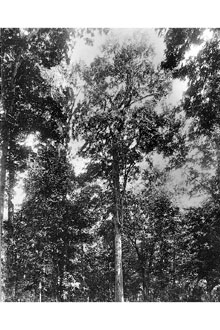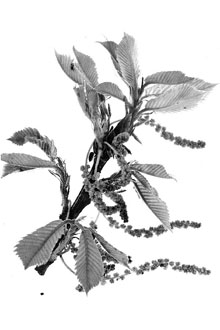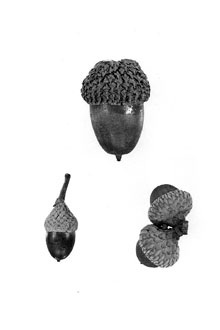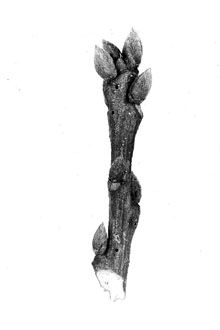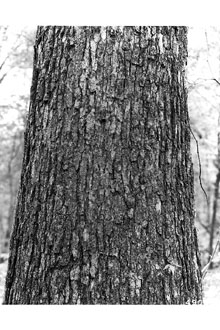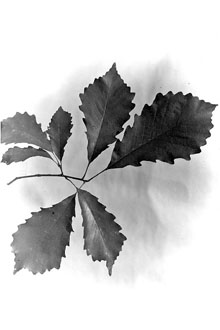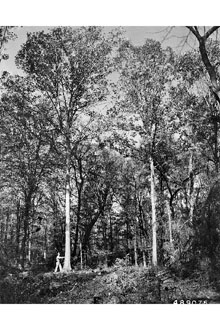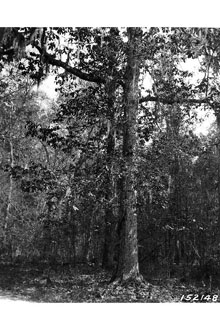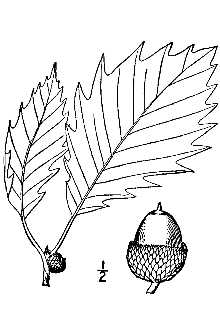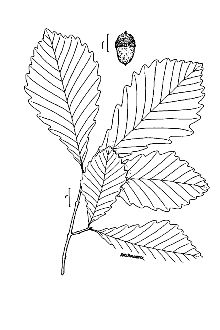Swamp Chestnut Oak
Scientific Name: Quercus michauxii Nutt.

| General Information | |
|---|---|
| Usda Symbol | QUMI |
| Group | Dicot |
| Life Cycle | Perennial |
| Growth Habits | Tree |
| Native Locations | QUMI |
Plant Guide
Use soil moisture sensors to measure the soil moisture of Swamp Chestnut Oak.
Fact Sheet
Alternate Names
basket oak, cow oak
Uses
Wildlife: Swamp chestnut oak acorns are eaten by white-tailed deer, wild hogs, wild turkey, black bear, squirrels, and chipmunks. The acorns are also eaten by cows. Timber: The wood is used in many kinds of construction; for agricultural implements, wheels, veneer, boards, fence posts, tight cooperage, baskets and fuel.
Status
Please consult the PLANTS Web site and your State Department of Natural Resources for this plant’s current status (e.g. threatened or endangered species, state noxious status, and wetland indicator values).
Description
Quecus michauxii Nutt,, swamp chestnut oak, grows along the Atlantic Coastal Plain from New Jersey south to north Florida, and west to east Texas; its range extends up the Mississippi River Valley to Illinois and Ohio, It is a medium-size to large tree that grows up to over 100 feet tall, with a trunk to over 6 feet in diameter, and a thick, scaly, loose, light-gray bark, The leaves are deciduous, somewhat oval, and 4 to 9 inches long; they are short-pointed at the tip, tapering to rounded at the base, with numerous shallow lobes or rounded teeth along the edges, dark green, smooth above and softly hairy beneath, Leafstalks are 1 inch long, The acorns are large and usually produced singly or in clusters of 2 or 3, There are 85 acorns per pound, Use soil moisture sensors to measure the soil moisture of Swamp Chestnut Oak.,
Adaptation and Distribution
Distribution
Distribution
Although the species is widely distributed on the best well-drained loamy first-bottom ridges, it is principally found on well-drained silty clay, loamy terraces, and colluvial (rocky deposit) sites in the bottomlands of large and small streams. For a current distribution map, please consult the Plant Profile page for this species on the PLANTS Website. Robert H. Mohlenbrock USDA NRCS 1989. Midwestern Wetland Flora @USDA NRCS PLANTS
Establishment
Although it is not a prolific sprouter, swamp chestnut oak can vegetatively reproduce by sprouts from roots and stumps. Regeneration from seed is greatly hindered by animal activity. Seed germination takes place soon following seedfall, with literally no period of dormancy. A moist, well-drained loam, covered with a light litter layer, provides an excellent seedbed. It is site sensitivity with growth greatly influenced by soil type and drainage. Acorns may be drilled in rows 8 to 10 inches apart or broadcast and covered with ¼ inch of firmed soil. In a nursery setting, seedbed densities of 10 to 35 acorns per square foot are recommended. Fall-sown beds should be mulched to protect seeds and seedlings. Partial shade is beneficial for germination. Seedlings are transplanted after the first year.
Management
Swamp chestnut oak is shade intolerant and requires openings for establishment. It normally receives heavy competition from vines, annuals, and brush that are common to most bottomland hardwood sites. When mature, they retard the growth of understory vegetation because they are allelopathic, that is, they exude plant growth inhibitors.
Plant Traits
Growth Requirements
| Temperature, Minimum (°F) | -20 |
|---|---|
| Adapted to Coarse Textured Soils | No |
| Adapted to Fine Textured Soils | Yes |
| Adapted to Medium Textured Soils | Yes |
| Anaerobic Tolerance | None |
| CaCO3 Tolerance | None |
| Cold Stratification Required | No |
| Drought Tolerance | Low |
| Fertility Requirement | Medium |
| Fire Tolerance | Low |
| Frost Free Days, Minimum | 180 |
| Hedge Tolerance | None |
| Moisture Use | Medium |
| pH, Maximum | 6.5 |
| pH, Minimum | 4.5 |
| Planting Density per Acre, Maxim | 800 |
| Planting Density per Acre, Minim | 300 |
| Precipitation, Maximum | 70 |
| Precipitation, Minimum | 40 |
| Root Depth, Minimum (inches) | 28 |
| Salinity Tolerance | None |
| Shade Tolerance | Intolerant |
Morphology/Physiology
| Bloat | None |
|---|---|
| Toxicity | None |
| Resprout Ability | Yes |
| Shape and Orientation | Erect |
| Active Growth Period | Spring and Summer |
| C:N Ratio | High |
| Coppice Potential | No |
| Fall Conspicuous | Yes |
| Fire Resistant | No |
| Flower Color | Yellow |
| Flower Conspicuous | No |
| Foliage Color | Green |
| Foliage Porosity Summer | Dense |
| Foliage Porosity Winter | Porous |
| Foliage Texture | Medium |
| Fruit/Seed Conspicuous | Yes |
| Nitrogen Fixation | None |
| Low Growing Grass | No |
| Lifespan | Moderate |
| Leaf Retention | No |
| Known Allelopath | No |
| Height, Mature (feet) | 80.0 |
| Height at 20 Years, Maximum (fee | 35 |
| Growth Rate | Moderate |
| Growth Form | Single Stem |
| Fruit/Seed Color | Brown |
Reproduction
| Vegetative Spread Rate | Slow |
|---|---|
| Small Grain | No |
| Seedling Vigor | Medium |
| Seed Spread Rate | Slow |
| Fruit/Seed Period End | Fall |
| Seed per Pound | 85 |
| Propagated by Tubers | No |
| Propagated by Sprigs | No |
| Propagated by Sod | No |
| Propagated by Seed | Yes |
| Propagated by Corm | No |
| Propagated by Container | Yes |
| Propagated by Bulb | No |
| Propagated by Bare Root | Yes |
| Fruit/Seed Persistence | No |
| Fruit/Seed Period Begin | Summer |
| Fruit/Seed Abundance | Medium |
| Commercial Availability | Routinely Available |
| Bloom Period | Mid Spring |
| Propagated by Cuttings | No |
Suitability/Use
| Veneer Product | Yes |
|---|---|
| Pulpwood Product | No |
| Protein Potential | Low |
| Post Product | Yes |
| Palatable Human | No |
| Palatable Browse Animal | Medium |
| Nursery Stock Product | No |
| Naval Store Product | Yes |
| Lumber Product | Yes |
| Fuelwood Product | High |
| Fodder Product | No |
| Christmas Tree Product | No |
| Berry/Nut/Seed Product | No |

